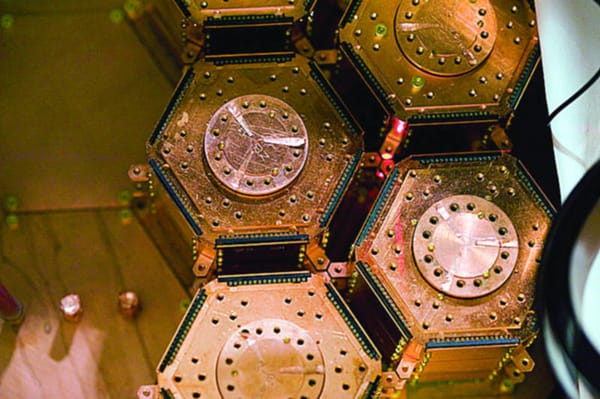Reversing the arrow of time
Forgotten what happened last night? Now you know why

This may end up in the bullshit graveyard of sensationalist physics speculation, but seemingly impossible occurrences – such as a shattered pane of glass returning instantaneously to its original form, a Latte separating back into pure coffee and milk, or Megan Fox replying to my emails – are not as conceptually absurd as they may appear at first glance.
Take the Starbucks Skinny Cinnamon Dolce Latte for example. Intuition tells us that once you have mixed the key ingredients of coffee, milk, cinnamon and pretentiousness, you can never recover them in their pure form. Yet the laws of physics that we worship and occasionally tattoo on ourselves are for the most part ‘time-invariant’ – in lay-douche terms, that means they work just as well going forwards and backwards in time. They are fundamentally symmetrical equations. So why can’t the chav un-break a library window and un-verdict himself an ASBO?
The reason is that in the real world (i.e. the one where Mr T is not allowed to randomly murder warlocks) – the majority of physical processes are ‘irreversible’. This is governed by the super-exciting ‘Second Law of Thermodynamics’, which states that the change in entropy of a system is always positive. The entropy of a physical system is its extent of disarray, essentially the number of ways in which the system can be arranged. Windows can be shattered, which increases disorder, but will never spontaneously un-shatter. Gases disperse naturally (especially in crowded elevators), but will not spontaneously compress themselves. Therefore the ‘entropy of the universe’ always increases. (Disclaimer: for every macroscopic system there IS a finite possibility that the entropy can decrease, but the probability of this happening is so small that it is unlikely to have occurred once since the beginning of the universe. Even if you had a million baboons conducting thermodynamics experiments all day since the dawn of time. No toilet breaks. I’m serious.)
So what this clown Lorenzo Maccone reckons is that counter-intuitive decreases in entropy happen all the time, the snag is that we just fail to remember them! Before you sigh and flick to the centre page (I’ve seen it already and I can quite sincerely say unless you are bulimic it’s not worth it), Maccone claims his findings do not violate any laws of quantum physics. Plus he went to MIT, so he can’t be a complete head case (MIT is almost as good as Imperial right?).
His argument is based on the premise that according to quantum mechanics, if anyone does observe an entropy-decreasing event, their memories of the event “will be erased by necessity”. Your memories will form and then be subsequently erased. Witnessing a system or process means you enter into a “quantum entanglement” with it (there’s scope for yet another dorky chat-up line here). In other words, you and the system are entangled and cannot truly be described independently. The entanglement, according to our amico Lorenzo, is between your memory and the system. The crucial step is the removal of this entanglement, and “the disentangling operation will erase this entanglement, namely the observer’s memory”.
This all sounds a bit like something Morpheus would say to Neo, before re-adjusting his ridiculous specs and scratching his ass. Nevertheless the thought experiment Maccone uses to elucidate his idea is fairly easy to understand (Medics...don’t worry about it): ‘An experimenter, Alice, measures the spin state of an atom sent by her friend Bob, who is otherwise isolated from Alice’s laboratory. The atom is in a combined state (superposition) of spin-up and spin-down until Alice measures it as either up or down. From Alice’s perspective, her lab gains a single bit of information from outside, and it’s then copied and recorded in her memory and on her computer’s hard drive. That information flow from atom to lab increases entropy, according to Alice. Because Bob doesn’t see the result, from his perspective the spin state of the atom never resolves itself into up or down. Instead it becomes quantum mechanically correlated, or “entangled,” with the quantum state of the lab. He sees no information flow and no change in entropy.
Bob has total control of the quantum state of her lab. To reduce the entropy of the lab from Alice’s point-of-view, Bob reverses the flow of that one bit of information by removing any record of the atom’s spin from Alice’s hard drive and her brain. He does so by performing a complicated transformation that disentangles the lab’s quantum state from that of the atom.
From Bob’s perspective, the quantum information of the atom plus Alice’s lab is the same whether or not the two are entangled – there is no change in entropy as viewed from the outside. Such reversals could happen in real life but because the Universe – like Alice – would retain no memory of them, they would have no effect on how we perceive the world.’
You might say that since this thought experiment is attempting to portray Maccone’s ideas as viable in the real world, he’s is doing himself no favours by pretending one of the physicists is actually a girl. Alice? More like Alan. Either way, my opinion is that his logic seems to hold. Whether it applies to our universe is incontestably another question altogether. But, like a cup of coffee getting cold while you argue with the Library cafe staff about the necessity of a tray, or a pint glass shattering into hundreds of pieces due to reasons unrelated to Snakebite, it would be ‘sickmansick’ if these things did happen in reverse. And memories of events being erased by necessity, especially if that event is Sports night, is something you are all familiar with.








